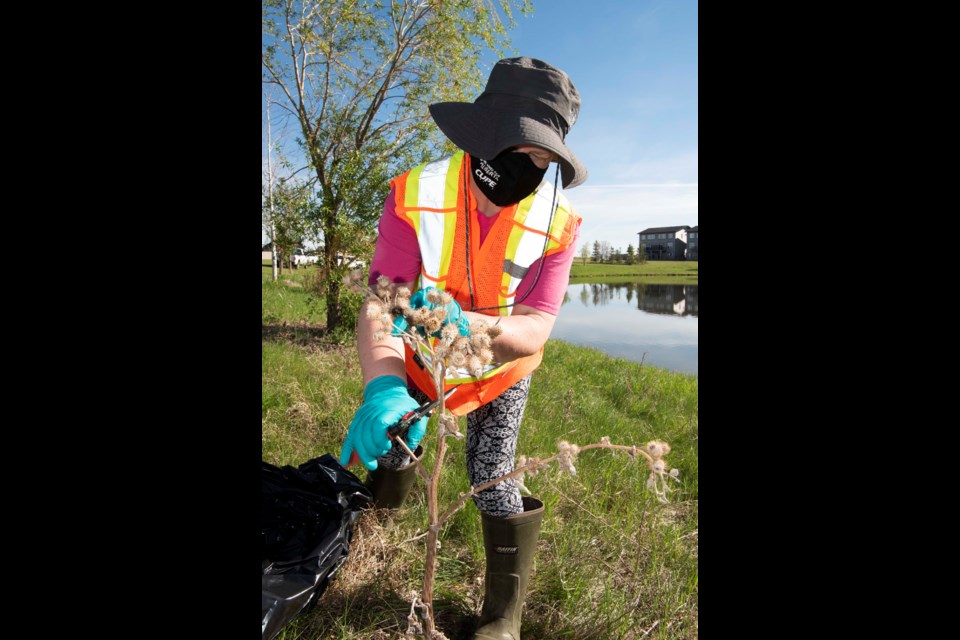St. Albert’s parks and open spaces are in full bloom this summer, and unfortunately so are the weeds.
The Gazette checked in with the city’s weed patrol on June 2 at the Element Stormwater Management Facility by Lois E. Hole School as part of Recreation and Parks Month, which runs throughout June.
Crews started patrolling the city’s natural areas for invasive weeds as soon as the snow melted in April, and have now moved onto stormwater ponds, said weed and pest team leader Kevin Veenstra. Their aim was to find any of the 12 noxious and prohibited noxious weeds known to exist in St. Albert and cut, pull, or spray them into oblivion before they crowd out native species in our parks and forests. (Alberta law requires municipalities to control noxious weeds and destroy prohibited noxious ones.)
In many cases, that means going back to the same spots year after year to stomp down entrenched populations. Garlic mustard (green heart-shaped leaves that smell like garlic when crushed) was first spotted blanketing the Forest Lawn Ravine in 2010, for example, and Veenstra and his crews were still yanking bags and bags of it out of the ground there 11 years later. It took six people four days to round up the city’s garlic mustard this year — about 40 bags of it.
“Which is amazing, because it used to be two weeks for eight people,” Veenstra said — they’re slowly making progress.
Persistence pays off
The pandemic both helped and hindered the city’s weed-control efforts in 2020, said city parks operations supervisor Erin Pickard. While crews cut back on turf control of unregulated weeds such as dandelions to save money, they also had a whole lot more people available to pull weeds since all the pools and rec centres were closed. These trends would continue this summer, so don’t expect your soccer fields to be weed-free.
Veenstra said last year’s floods had mixed effects on flowering rush — the towering pink-blossomed invader choking off parts of the Sturgeon. High water levels made it impossible to reach many patches, but also let freshwater shrimp attack the rush’s roots. Veenstra said crews would don hip-waders and board boats this July once spawning season was over to root out the rushes.
At the Element pond, Veenstra and his team were on the lookout for common tansy, common burdock, and scentless chamomile, which in recent years have blanketed many of the city’s forest floors and riverbanks. They dig each up by hand, saving sprays for only the worst infestations.
“The mantra in weed control is, ‘early detection and rapid response,’ ” Veenstra said — by spotting and extracting these plants before they can flower, crews prevent them from releasing thousands of seeds and reduce the need for chemical controls.
This was also true for dead plants left over from last year. Veenstra’s crew carefully clipped and bagged several child-high patches of common tansy (known for its button-shaped yellow blossoms) and burdock (huge leaves, burr-like seeds), as the seeds from them could still be viable.
Veenstra said crews would be out pulling weeds from city property all summer long. There won’t be any public Weed Warrior events due to the pandemic, but Pickard hoped to start the usual Weed of the Week education campaign in the coming weeks.
Veenstra encouraged residents to play, clean, and go after an outdoor romp. That means checking and cleaning clothes, equipment, and pets for bugs, dirt, and seeds before they leave any site, and not picking wildflowers (which were often invasive weeds).
“We are the vectors of the weed,” Veenstra said, and our actions can control their spread.
Anyone who spots a suspected invasive weed in St. Albert should report it to public works at 780-459-1557 or through EDDMapS.org. See stalbert.ca/city/environment/natural/weeds/weeds-of-concern for details on known invasive weeds in St. Albert.




